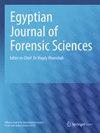利用 Magnetic Resonance Imaging 测量埃及人手脚的性别估计值
IF 1.3
Q3 MEDICINE, LEGAL
引用次数: 0
摘要
骨骼遗骸的鉴定首先要进行性别评估,因为其他生物特征要素,如体型和年龄,都有性别特异性。骨盆是性别评估的首选要素,因为它具有很强的性别二态性。为埃及人口鉴定提供手骨和脚骨性别估计标准是这项工作的目标。82 名年龄≥ 21 岁的埃及成年受试者(41 名男性和 41 名女性)接受了右手和右脚的核磁共振成像扫描,以评估 9 项测量指标:手长、手宽、中掌骨的四项测量指标(长、宽、头宽和基底宽)、第一跖骨长、第一跖骨宽和(第一跖骨长 x 第一跖骨宽)。男性右手和右脚的所有测量参数均高于女性。足部的第一跖骨长 x 第一跖骨宽和手部的中掌骨宽是最具性别二态性的参数,准确率分别为 86.6% 和 84.1%。在逐步判别分析中,九个测量值中有三个被选中:第一跖骨长 x 第一跖骨宽、中掌骨宽和手宽被选中用于埃及人群的性别预测方程,交叉验证的性别分类准确率为 90.2%。通过核磁共振成像测量的手脚度量参数来评估性别的准确率很高。本文章由计算机程序翻译,如有差异,请以英文原文为准。
Sex estimation using Magnetic Resonance Imaging measurements of hand and foot in Egyptian population
The identification of skeletal remains begins with a sex evaluation since other biological profile elements, such as size and age, are sex-specific. The pelvis is the favored element for sex assessment since it is very sexually dimorphic. Delivering hand and foot bones sex estimate criteria for Egyptian population identification was the goal of this work. Eighty-two Egyptian adult subjects (41 males and 41 females) aged ≥ 21 years old were subjected to MRI scan on the right hand and foot to assess 9 measurements: hand length, hand width, four measurements of middle metacarpal bone (length, breadth, head breadth and base breadth), first metatarsal bone length, first metatarsal bone width and (first metatarsal bone length x first metatarsal bone width). All the measured parameters in the right hand and foot were higher in males than females. First metatarsal bone length x first metatarsal bone width in the foot and middle metacarpal bone breadth in the hand were the most sexually dimorphic parameters, with accuracy of 86.6 percent and 84.1 percent, respectively. In stepwise discriminant analysis, three of nine measurements were selected: First metatarsal bone length x first metatarsal bone width, middle metacarpal bone breadth and hand width for the sex prediction equation in the Egyptian population, with a cross-validated sex classification accuracy of 90.2%. Sex can be assessed from hand and foot metric parameters measured by MRI with high accuracy.
求助全文
通过发布文献求助,成功后即可免费获取论文全文。
去求助
来源期刊

Egyptian journal of forensic sciences
MEDICINE, LEGAL-
CiteScore
2.00
自引率
0.00%
发文量
51
审稿时长
17 weeks
期刊介绍:
Egyptian Journal of Forensic Sciences, the official publication of The International Association of Law and Forensic Sciences (IALFS), is an open access journal that publishes articles in the forensic sciences, pathology and clinical forensic medicine and its related specialities. The journal carries classic reviews, case studies, original research, hypotheses and learning points, offering critical analysis and scientific appraisal.
 求助内容:
求助内容: 应助结果提醒方式:
应助结果提醒方式:


